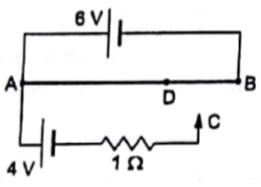A 6-volt battery of negligible internal resistance is connected across a uniform wire AB of length 100 cm. The positive terminal of another battery of emf 4V and internal resistance 1Ω is joined to the point A as shown in figure. Take the potential at B to be zero.
(a) What are the potentials at the points A and C?
(b) At which point D of the wire AB, the potential is equal to the potential at C?
(c) If the points C and D are connected by a wire, what will be the current through it?
(d) If the 4V battery is replaced by 7.5 V battery, what would be the answers of parts (a) and (b)?

Concepts/Formula used:
Ohm’s Law:
Potential Difference (V) across a resistor of resistance R when current I passes through it is given by Ohm’s law:
![]()
Let the area of cross section of the wire (resistor) be A and resistivity be ρ.
Then,
![]()
(a)
![]()
As ![]() ,
,
![]()
Let us account for the potential differences when moving from A to C.
![]()
![]()
(b)
![]()
![]()
Let the area of cross section of wire be A and resistivity be ρ.
Then,
![]()
where V is the voltage across a wire segment of length l.
As, all the quantities except for length are the same for all sections of wire AB,
![]()
Hence,
![]()
![]()
![]()
Hence, D is 66.67cm away from A.
(c) As ![]() , there is no potential difference across CD and hence, the current through it is zero.
, there is no potential difference across CD and hence, the current through it is zero.
(d)
(a)
![]()
As ![]() ,
,
![]()
Let us account for the potential differences when moving from A to C.
![]()
![]()
(b)
![]()
![]()
Let the area of cross section of wire be A and resistivity be ρ.
Then,
![]()
where V is the voltage across a wire segment of length l.
As, all the quantities except for length are the same for all sections of wire AB,
![]()
Hence,
![]()
![]()
![]()
This is not possible. As the length of the wire is only 100cm. There is no such point D.